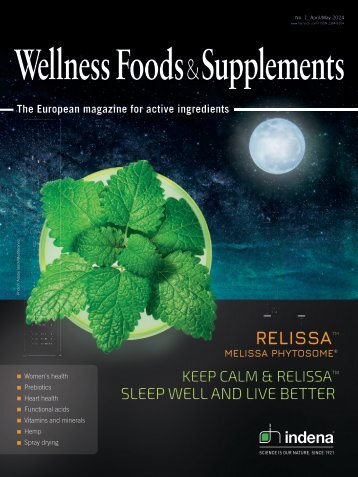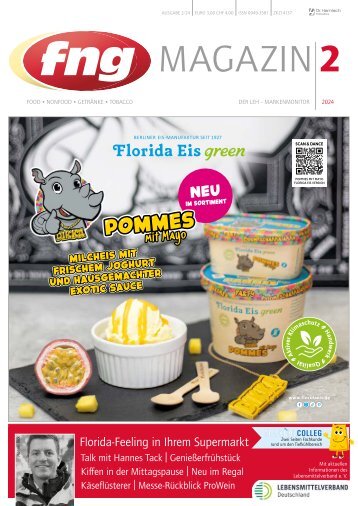Wellness Foods & Supplements 3/2020
- Text
- Harnischcom
- Supplements
- Foods
- Wellness
- Clinical
- Salts
- Protein
- Dairy
- Vaginal
- Products
- Yogurt
- Mineral
- Calcium
- Magnesium
Fortified dairy
Fortified dairy alternatives instead of a soy-based one to find out whether stability can be maintained if a different plant protein is used. Provided that the yoghurt is processed as recommended, it was found that these versions did not demonstrate a lack of stability. However, the recommendations for the processing step must be followed meticulously. Conclusion The experiments described above show that mineral salts can be added to milk alternatives without any negative impact on texture or stability, and that this process can even be exploited to mask various undesired plant off-notes. Different plants proteins create varied undesired flavours, so selecting the right mineral salt plays an essential role in successfully masking such off-notes. Some mineral salts (e.g. trimagnesium citrate) can even fulfil a dual function, enhancing flavours on the one hand and helping achieve fortification claims on the other. added in small quantities before heat treatment. The levels generally depend on the type of milk alternative in question, as the different plant proteins vary in their sensitivity to applied stress in form of heat, pH changes or shear forces. Adding tricalcium citrate and trimagnesium citrate after the heating step to produce a high-magnesium/high-calcium soy yoghurt (in line with FDA standards) did not have any negative impact on the yoghurt’s texture, stability or appearance. The level of magnesium and calcium fortification required for a “high in calcium/magnesium” claim is higher under the EU standards than the US standards. Therefore, a test was also carried out to find out whether the stability and texture of non-dairy yoghurt can be maintained if even higher levels of mineral salts are added after the heating stage. Again, this experiment produced soy yoghurt with normal yoghurt-like stability and texture, demonstrating that high amounts of minerals can be incorporated into the yoghurt matrix after the heating step without any detectable loss of stability or texture. Nowadays, various types of plant proteins are on the rise. Peas are a particularly common new ingredient for non-dairy yoghurts. The trials were therefore repeated using a pea-based yoghurt matrix For more information, please contact Dr. Sabrina Fischer – Junior Product Manager sabrina.fischer@jungbunzlauer.com Miriam Feja – Application Technology Assistant miriam.feja@jungbunzlauer.com Jungbunzlauer Ladenburg GmbH www.jungbunzlauer.com Regarding non-dairy yoghurt and its complex texture, the experiments with soy yoghurt showed that mineral salts can be successfully added – even in large quantities – without having to compromise on taste, texture or stability of the final product. References [1] Hashemi Gahruie, H.; Eskandari, M. H.; Mesbahi, G. & Hanifpour, M. A. Scientific and technical aspects of yogurt fortification: A review. Food Sci. Hum. Wellness 4, 1–8 (2015). [2] Sethi, S.; Tyagi, S. K. & Anurag, R. K. Plant-based milk alternatives an emerging segment of functional beverages: a review. J. Food Sci. Technol. 53, 3408–3423 (2016). [3] Ranadheera, C. S.; Vidanarachchi, J. K.; Rocha, R. S.; Cruz, A. G. & Ajlouni, S. Probiotic delivery through fermentation: Dairy vs. non-dairy beverages. Fermentation 3, 1–17 (2017). [4] Chalupa-Krebzdak, S.; Long, C. J. & Bohrer, B. M. Nutrient density and nutritional value of milk and plant-based milk alternatives. Int. Dairy J. 87, 84–92 (2018). [5] Gerhart, M. & Schottenheimer, M. Mineral fortification in dairy. Wellness Foods Eur. (2013). [6] Domke, A.; Großklaus, R.; Niemann, B.; Przyrembel, H. & Richter, K. Verwendung von Mineralstoffen in Lebensmitteln. Bundesinstitut für Risikobewertung (2004). [7] Harvey, J. A. et al. Superior Calcium Absorption from Calcium Citrate than Calcium Carbonate Using External Forearm Counting. J. Am. Coll. Nutr. 9, 583–587 (1990). [8] Kappeler, D. et al. Higher bioavailability of magnesium citrate as compared to magnesium oxide shown by evaluation of urinary excretion and serum levels after single-dose administration in a randomized cross over study. BMC Nutr. 3, 1–12 (2017). [9] Zhu, K. & Prince, R. L. Calcium and bone. Clin. Biochem. 45, 936–942 (2012). [10] Włodarek, D. et al. Calcium intake and osteoporosis: The influence of calcium intake from dairy products on hip bone mineral density and fracture incidence – A populationbased study in women over 55 years of age. Public Health Nutr. 17, 383–389 (2014). [11] Schumann, L.; Martin, H.-H. & Keller, M. Calcium, Milch und Knochengesundheit. Behauptungen und Fakten. Ernährung im Fokus 14, 326–331 (2014). [12] USDA Advisory Committee. Scientific Report of the 2020 Dietary Guidelines Advisory Committee. (2020). [13] Rene, R. Dairy products, yogurts, and bone health. Am. J. Clin. Nutr. 99, 1256S–1262S (2014). [14] U.S. DEPARTMENT OF AGRICULTURE. Soy milk. FoodData Central https://fdc.nal.usda. gov/fdc-app.html#/food-details/781114/nutrients, accessed on 6th August 2020. [15] U.S. DEPARTMENT OF AGRICULTURE. Coconut milk. FoodData Central https://fdc.nal. usda.gov/fdc-app.html#/food-details/572117/nutrients, accessed on 6th August 2020. [16] Gerstner, G. Dairy products: the calcium challenge. Int. Food Ingredients 3, 45–48 (2002). [17] Younes, M. et al. Re-evaluation of phosphoric acid-phosphates – di-, tri- and polyphosphates (E 338–341, E 343, E 450–452) as food additives and the safety of proposed extension of use. EFSA J. 17, 5674 (2019). [18] Besler, L. & Gerstner, G. Formulating better tasting infant formula. Jungbunzlauer Fact Sheet (2015).15 38 No. 3 November/December 2020
Dairy products Photo ® : Fotolia/emuck Yogurt Powders: the health benefits of yogurt with added convenience Harmony Villemin, on behalf of Epi Ingredients According to the Codex Alimentarius, yogurt is a fermented milk characterized by the use of specific starter cultures for fermentation, symbiotic cultures of Streptococcus thermophilus and Lactobacillus delbrueckii subsp. Bulgaricus, which shall be viable, active and abundant ( >10 7 CFU/g ) in the product throughout its shelf life; unless the product is heat treated after fermentation in which case some of these requirements do not apply. Although yogurt-making now relies on standard starter cultures to provide a consistent product, ensure quality and safety and meet consumer expectations, it was not always the case. Evidence of the consumption of fermented milk dates to ancient times when fermentation was the result of the spontaneous activity of native bacteria in milk and primarily used to preserve it. As such, yogurt has been a significant part of the human diet for centuries in many cultures. Not only was it used to extend milk’s shelf life, but its nutritional benefits were also recognized early on and it was consumed for its medicinal proper ties as early as the Middle Ages to heal conditions such as diarrhea or burnt skin. Nowadays, yogurt’s perceived health benefits are still a major driving force behind its consumption as increasingly healthconscious consumers seek simple natural solutions to support their pursuit of a healthy lifestyle. Beyond the appeal of its distinctive tangy flavor, a lot of consumers are attracted to yogurt for its alleged positive effects on digestive health, which most people now understand is the foundation for overall wellness. Yogurt has indeed become a true health food staple. It is indeed packed with the nutrients from milk, such as high quality protein, calcium, and other valuable vitamins and minerals, and also contains additional beneficial compounds resulting from the microbiota’s metabolic activity, not to mention the live cultures themselves and their own positive impact on human health.” Beneficial health effects of yogurt Although yogurt and other fermented dairy products have been consumed for millennia and often associated with good health and longevity, it is not until more recently that scientists began to explore their potential health benefits. “The lactic acid bacteria present in fermented milk are suggested to confer beneficial effects on human health through the modulation of the intestinal microbiota, which affects the host either directly or indirectly.” 1 Yoghurt cultures promote better lactose digestion One of the most studied benefit of yogurt pertains to its role in lactose digestion and relates to products containing live cultures of Lactobacillus delbrueckii, Lactobacillus bulgaricus and Lactobacillus Streptococcus. The European Food Safety Authority (EFSA) has even approved the following generic claim: “yoghurt helps to promote No. 3 November/December 2020 39
- Seite 1: No. 3, November/December 2020 www.h
- Seite 4 und 5: Contents Health Convenience Food Fo
- Seite 6 und 7: Oils and fats Photo © : 123rf/jirk
- Seite 8 und 9: Oils and fats sive “key figure”
- Seite 10 und 11: Functional sugars Photo © : Jennew
- Seite 12 und 13: Nutrition and ageing Photo © : Ado
- Seite 14 und 15: Nutrition and ageing demineralizati
- Seite 16 und 17: Nutrition and ageing Proferrin ® ,
- Seite 18 und 19: Energy and endurance system is conn
- Seite 20 und 21: Minerals Photo ® : Adobe Stock/nd3
- Seite 22 und 23: Minerals Health Claims Magnesium co
- Seite 24 und 25: Women‘s health Probiotics for wom
- Seite 26 und 27: Women‘s health How can oral probi
- Seite 28 und 29: Clinical trials Photo ® : Adobe St
- Seite 30 und 31: Clinical trials methods; and the sa
- Seite 32 und 33: Fortified dairy alternatives Minera
- Seite 34 und 35: Fortified dairy alternatives Dairy
- Seite 36 und 37: Fortified dairy alternatives theref
- Seite 40 und 41: Dairy products lactose digestion”
- Seite 42 und 43: Dairy products EPILAC premium yogur
- Seite 44: Come and see for yourself: www.harn
Unangemessen
Laden...
Magazin per E-Mail verschicken
Laden...
Einbetten
Laden...




























































































































































































































































































